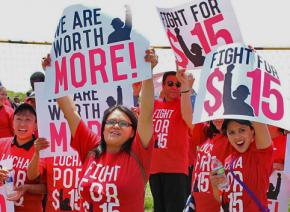Raising wages...and expectations, too
With low-wage workers and their supporters ready to take action in the next round of the Fight for 15, looks at the backdrop to the struggle and its first victories.
NO SINGLE day demonstrates inequality in America more than April 15.
For most of us, Tax Day is a major occasion--either to stress out about coughing up hard-earned money or to hope for desperately needed refunds. But for rich people, April 15 is just another day to celebrate how they're getting over on everyone else.
For starters, members of the 1 Percent can raise a glass over the fact that their tax rate has been cut almost in half in the past four decades or so--from 70 percent to under 40 percent today. But that's before their accountants find all the loopholes the government has created just for them.
The richest 1 percent of American households, those with at least $327,000 in annual income, pocket 17 percent of the country's 10 biggest tax breaks, according to a Congressional Budget Office report. That's a gift of $153 billion each year to the people who need it the least.
To put that statistic in perspective, it would only cost $20 billion a year to bring the pay of all the workers at the major fast-food chains up to $15 an hour. Just in case anybody was wondering where the money could possibly come from to pay for a living wage.

This year, however, April 15 symbolizes not just the greed and gluttony of the wealthy, but the growing determination among many of the workers who produce their wealth to demand a living wage, starting at $15 an hour.
Organizers with the Fight for 15 campaign predict that fast-food workers will mark the day of action called for April 15 by striking in hundreds of cities across the U.S.--and that they'll be joined by workers in other low-wage jobs, from home health aides to adjunct professors, along with tens of thousands of supporters at rallies across the nation and 35 other countries.
In New York City, hundreds of unionized construction workers--who generally make far more than $15 an hour--plan to march in support. Ironworker Anthony Devarel told the New York Daily News that he used to make $12 an hour before he got into the union and knows what it's like to not be able to afford an apartment.
"Everywhere I go, even in the barbershop," Devarel said, "people are saying these big companies could pay $15. They just don't want to, they act like it's going to hurt them in some kind of way. It's not fair."
Organizers also expect protests to take place on 170 college campuses--in addition to the many students who will be joining off-campus rallies. In a sign of how the movement for $15 has spread beyond fast food and retail, many of university protests will focus on adjunct professors, almost a third of whom live in poverty.
THE LOW-wage worker movement has grown massively since 200 fast-food workers in New York City staged a one-day strike in the final months of 2012, just days after Walmart workers grabbed national attention with their Black Friday walkouts and protests.
Since then, fast-food worker organizations demanding a $15 an hour wage and a union have sprouted up across the country, often with the organizational backing and resources from big unions, like the Service Employees International Union (SEIU).
In addition to the labor-backed days of strikes and protests, there are local campaigns to win city ordinances requiring $15 an hour. These efforts achieved a breakthrough last year in Seattle when the City Council passed a new minimum wage law. Though the Seattle ordinance has a long phase-in period that will keep the minimum wage below $15 for some years, the struggle in Seattle sent a signal that $15 is an achievable demand. Building on this win, activists in the Bay Area supported living wage referendums that passed easily last November.
After years of defending the low-wage economy, politicians and the corporations they serve are scrambling to support measures that they hope will placate the sentiment in support of the Fight for 15--a poll released earlier this year shows 63 percent of people support raising the minimum wage to $15 an hour. Some no doubt hope to take momentum away from the growing movement.
According to USA Today, 21 states will raise their minimum wage in 2015. Nine states have automatic increases to keep pace with inflation, eight states passed legislation mandating the hike, and four--Alaska, Arkansas, Nebraska and South Dakota, all known for being conservative--approved ballot initiatives last November to raise the minimum wage.
Meanwhile, last year, Ikea and The Gap were among the major employers that promised to raise workers' pay to at least $10 an hour.
The pressure to raise wages has become too strong for even the low-wage goliaths Walmart and McDonald's to resist.
Until recently, both corporations had firmly resisted the idea that there was anything wrong with what they paid their employees--or "associates," in the case of Walmart. McDonald's even created a website to show employees how to pay their bills and even put away some savings on an hourly wage of $8.25. The site became an Internet joke because it included such useful "budget tips" as getting a second job and not paying for heat.
This year, though, both companies have announced pay raises that will put workers over $10 an hour by next year.
Their promises are full of loopholes. Walmart said nothing about guaranteeing its "associates" full-time hours, which is as big an issue for its workers as low pay. And the pledge by McDonald's would only cover the 90,000 employees at company-owned locations--as opposed to the 750,000 people who work at locations that are franchised.
Despite these very real limitations, however, the fact that the two corporations that symbolize low-wage Corporate America are admitting they don't pay their workers enough is a major concession that our movement can use to win more substantial changes.
ONE OF the most important effects of the Fight for 15 movement has been to give a platform to low-wage workers, which has increased awareness about the prevalence of abusive labor practices reminiscent of some of the worst factory conditions from the 1800s.
McDonald's workers in the Fight for 15 campaign took dramatic video footage of the unsafe procedures they are often forced to use when handling scalding hot grease.
According to the campaign, four out of five fast-food workers suffered burns in the past year, and an incredible one-third of the victims were told by managers to treat the burns with mustard or mayonnaise. That medical expertise might explain why McDonald's old budgeting website advised employees they could spend only $20 a month on health care.
Meanwhile, low-wage workers in retail have been calling attention to the plague of on-call scheduling.
According to the Retail Action Project, "[O]nly 17 percent of retail workers surveyed have a set schedule, with the majority of workers increasingly facing unpredictable hours, on-call shifts, call-in pay violations, penalties for scheduling requests and benefits avoidance through 'legal misclassification.'"
A hundred years ago, workers were forced to work 12- and 14-hour days. Today, retail workers often have to be available for work for the same number of hours, though they're only called in for a fraction of that time. This makes it impossible to take classes, find a second job or make child care arrangements. The workers don't get paid for the waiting time spent waiting--only to be called in or told not to show up on less than a day's notice, based on what some company software program predicts about how busy a store will be.
IN RESPONSE to an investigation into on-call scheduling by New York's Attorney General Neil Trautwein, a vice president at the National Retail Federation dismissed workers' concerns: "It's a little bit of the flavor of the moment. And where there is flavor in the air, there are politics sure to follow."
Unfortunately for Trautwein and the corporations he shills for, the low-wage workers movement has already shown that it's more than a passing fad.
It hasn't succeeded in winning $15 and a union at any major corporation, but it has shone a spotlight on conditions for the 42 percent of people in the U.S. who make less than $15 an hour--and that statistic is surely an underestimation once undocumented and prison labor is accounted for.
Now, $15 is becoming the touchstone across the U.S. working class that the eight-hour day once was.
Workers in industries far afield from fast food are setting $15 an hour as their goal. Graduate student employees at NYU won $15 in their recent contract agreement. Nursing home workers in Connecticut and Pennsylvania are making $15 a goal in their rallies and strike votes. And UPS workers in New York City are rallying for part-timers to make $15 an hour.
In fact, SEIU is beginning a launching among adjunct professors to demand that they should be paid $15,000 a course--at a time when they are often typically paid less than $3,000. As blogger Lydia DePillis wrote in the Washington Post:
At the moment, the $15,000 number sounds even more outlandish than $15 did when fast-food workers started asking for twice the federal minimum wage. But organizers argue that if you're teaching a full load of three courses per semester, that comes out to $90,000 in total compensation per year--just the kind of upper-middle-class salary they think people with advanced degrees should be able to expect.
Raising our expectations is exactly the lesson we should draw from the success of the Fight for 15 movement so far--and we shouldn't forget it the presidential election campaign begins.
SEIU and other unions and organizations supporting the low-wage workers movement will surely support the Democratic nominee--with Hillary Clinton the early frontrunner--and that's likely to produce pressure on workers not to demand something so "unrealistic."
We shouldn't let politicians who have never known poverty set the terms for what's realistic. They're the ones--both Republicans and Democrats--who let the minimum wage stagnate for decades. If the federal minimum had kept up with inflation since 1968, it would now be $10.70 an hour.
The Fight for 15 was dismissed as pipe dream just a few years ago, but it's now looking very realistic. Hopefully, in a few year's time, we'll think of it as a modest starting point in the Fight for More.


